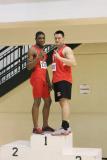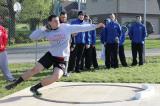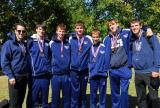By Andrew Adelmann
As I mentioned in my first post, it was my hope to break down some of the areas that arise in building a distance program in Chicago one-by-one and the most logical, and obvious, place to start is resources.
Resources in Chicago
For the sake of clarity, despite a dramatic increase in the status level of Chicago cross country and track in the state, the environment such teams face within the city has remain unchanged. The teams that have reached the next level have found ways to adapt (as I will explain how we did so at the end of this entry), but it does not necessarily mean that they should be faced with such undesirable scenarios to begin with.
Simply put, the resources are not there. There are three legitimate outdoor tracks that can be used by CPL teams for actual competition: Hanson Stadium, Eckersall Stadium and Lane Stadium. And as far as indoor stadiums it is simple: there are zero public tracks.
Hanson Stadium is a 440 yard track that was improperly marked as meters years ago during a resurfacing project. It and Eckersall are in terrible condition as is. Lane markings have all but worn off over the years and the condition of the surface is hardly desirable and venturing in to the territory of unsafe. A sizeable hole opened up in lane one right before the first 4x1 exchange zone last year and with each new March, upon the clearing of a long Chicago winter's snow, more divots and bubbles appear like a rite of spring.
What can be considered the crown jewel of CPS tracks, Lane Stadium, located at Lane Tech, is quickly going the way of other Chicago stadiums due to lack of proper upkeep and funding. The condition of the field event areas and surrounding stadium infrastructure at these stadiums is equally as deplorable in most cases. Thanks to two large generous grants from Nike in recent years, renovations were supposed to be started at Hanson, but somehow this money has not been put to use and it is my fear that generous companies such as Nike, who have done an incredible amount of work to support running in the city, will begin to donate their resources elsewhere.
In terms of competition, the lack of tracks is at least just a minor obstacle. It is the day-to-day practice for teams that becomes the issue. The majority of programs, us at Jones included, do not touch a track except for at meets. Count the number of meets we have and that is the exact amount of times our athletes run on a track during the year. Fortunately some teams (not us) are at least located near a public track and can squeeze in some training, albeit while sharing sometimes with 5-6 other teams (yes, 5-6) and the public, as is the case on the north side at River Park.. There are also a few schools, such as Lane, that do have their "own" tracks, but this is a bit of an exaggeration as they are still considered public district wide tracks that are not solely for the school's use.
Outside of track facilities though, as that is an understandably large expense, there are numerous other issues surrounding a lack of basic resources given the realities of an urban environment and the CPS.
While we are at least fortunate enough at Jones to be near the lakefront path, the areas for cross country and distance training at most schools are severely limited. Stopping at a stoplight every block or running through dangerous (sometimes extremely) neighborhoods or parks is hardly safe or productive for those runners. For sprints and field events, as mentioned, the lack of a proper track and supporting facilities is felt even greater. Add on top of this all the lack of rubberized surfaces, cinder paths or grass which all lead to a much greater wear and tear on an athlete's body and resulting injuries.
Resources are not limited to major infrastructure like facilities though. It should not be news to the average reader the state of CPS finances is in disarray. What may be more of a surprise, however, is how athletics are even in a more dire situation. The money is simply not there, and that which is present needs to be fully directed towards the students in the classroom, and rightfully so. However, it does not change the fact that a very beneficial outlet for many students, and often their ticket out, is still neglected.
Money for busses to get out of the city and compete amongst the best is limited, or often non-existent, perpetuating a cycle of mediocrity by never having the chance to raise the bar. Items like hurdles, jumping pits, and shots are legitimately non-existent at most schools. Even money for simple items like uniforms and warm-ups is scarce. Attend any city track or cross country meet and you will see most athletes wearing gym uniforms, tattered old mis-matched singlets, athletes warming up in jeans and the like. Most coaches have a budget of zero for these items and do not have student populations with the ability to help fundraise amongst family and neighbors. So what happens to the student in the halls who really has his eye set on being the next great high jumper? How do students buy in to a sport at the level needed when they don't have things to be proud of? Many athletes at the high school level still need external motivation coupled with the intrinsic to truly progress in a sport, but maybe that is a separate issue for a different time.
Confronting the situation at Jones
Our situation at Jones is not entirely different than our city brethren. We are certainly more fortunate than some, but we share the same pains as most.
Besides lacking a track, we also do not have a gym at Jones. While some schools have long hallways that can be utilized during the winter, our school, located in the Loop, is built upwards (seven stories) and our longest hallway is roughly 60-70 meters. We do have the lakefront path at our disposal, which we quickly categorized as a strength, and while we have the luxury of a nearby Grant Park, it is not as glorious as it seems. Every day a new section of the park is blocked off for some type of maintenance or event. From July through October most of the park is closed for festival season and resulting repairs. During the winter city budgets have left nothing aside for the cost of snow removal and we scramble to find spaces available for quality sessions.
Finding Our Strength
Our strengths were few, but they served as a starting point. Based on what we did have going for us, our focus immediately became distance running. For those familiar with Jim Collins' book Good to Great (highly recommended if not), he writes about how the best businesses become the best by following the "hedgehog concept.” Or, like as hedgehogs operate in the animal kingdom, doing one thing and doing it well. Quickly assessing via Collins' principle, we knew that assets such as our unique access to great distance running on the lakefront path, coupled with some other strengths to be mentioned in future posts, meant that our "hedgehog concept" would be advanced progressive distance training year round, even during track season.
“Have-Nots”
In light of our "have nots," we quickly realized that we would have to get creative, and just like stress causes an adaptatative response physiologically speaking, we realized that we could also use general obstacles within the building of our program to create an adaptatative response of sorts. In other words, a lack of resources would force us to think outside the box and be more efficient. Negatives could be turned in to positives and instead of brooding over what we supposedly could not do as “just another city school,” it became fuel.
Distance running is a sport of changes and from day one we have preached needing to adapt to these changes: within a race, throughout a season and over the course of a career. It has become a cornerstone of our program in everything we do and even in training, something that is typically constant for most teams, we practice this adaptability.
Mike Krzyewski, Duke’s legendary basketball coach, has written how he will often try to mix up practice environments and even places he hold team meetings because of the mental benefit it has on one’s ability to retain information. While we are often forced to “mix things up,” we also choose to do this as often we can, even when do not necessarily need to, as it has prevented us from getting complacent. The fact that we hardly ever workout on the same “loop” twice has better equipped our runners to deal with the often changing course conditions and layouts during a cross country season, as well as to better understand pacing without the track as a crutch. Necessity has given way to choice and our training plans are designed to be as dynamic as possible.
Similarly, we are forced to be outside everyday. In my five years of coaching here, training 48 weeks a year, we have been required to stay inside only six times due to district cancellations. No indoor facilities was a weakness, now it is a benefit. We have calloused greatly to weather conditions and have tried to use this toughness as an advantage. Snow, rain, extreme heat or cold and brutal lakefront winds, we are running, even for tough workouts. We have no other choice. They have learned through repeated trial-and-error how to race in every condition and understand how their individual bodies respond and how to properly prepare for what they will encounter.
Beyond facilities, creativity is still king, but simplicity is moreso. When you start with less you focus on the basics and we have made our living, so to speak, in the fundamentals of the sport. Lacking the latest equipment or technology is one of the easiest barriers to overcome. Often time athletes today will neglect the “little things” as they do not always yield immediate results and that is where too many resources can cloud a team’s vision. The allure of the latest and greatest equipment in the room is yielded to before a proper “training age,” or foundation, is built. Leading minds in the area of athletic development, like Vern Gambetta (who happens to be a large influence in our supplemental training), have been the first to point out that young athletes, especially emerging high school distance runners, need to develop in the basics of movement first. Functional training is a building block that does not require the resources that many city teams like us do not have in the first place.
Financially speaking, we had to build our program from near scratch. This was certainly a major challenge and money is probably the greatest hindrance to city programs in general. However, we knew that raising money would be vital to building in two ways: (1) It would obviously allow us to operate a larger program and afford our athletes more opportunities and resources, and (2) the process of raising this money would have residual benefits as well. Yes, the end result of money in the account is extremely important. As mentioned before, having "gear" to be proud of, trips to attend, and any rituals that cost money are a big part of the athlete's buy-in to the program and they also help bring teammates together. But we also capitalized on the challenge of needing to raise so much money by reaping the residual benefit of "ownership." The very process itself is like when investors fund a business: people take responsibility, they play a more active role and become much more vested in the final outcome of things. The fact that money has not been handed to us has made everyone gain a better appreciation for what we do day-in and day-out.
On Display
I suppose that all of what has been written here is no better on display than by looking at last fall when the teacher’s strike hit the CPS (read Mike Newman’s account here: ). The team’s ability to get through those ten days had nothing to do with good coaching, but was only a testament to the guys and the adaptability that our program has developed and built on from the first days of our time together. In a sport where discipline and focus is often the key to high performance, an environment that forces such qualities prepared that team for anything. Finding ways to adapt, in all components of our program, has been fundamental in reaching the level that we have reached, but reacting to a lack of resources is only part of it. The support that is necessary to cultivate a cross country/track program is also an obstacle faced by city schools and will be the subject of the next post in this series.







